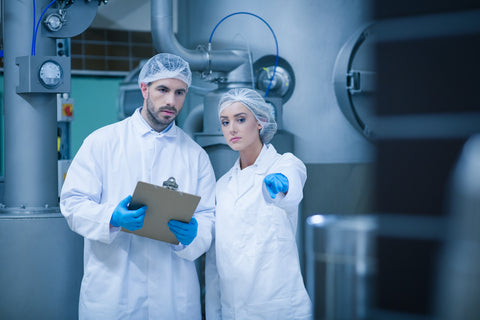
The Roles of Safety Gloves
The glove plays different roles in food plant sanitation, which includes personal hygiene. It can protect hands from injury and protect food from hands. They are used in production, cleaning and sanitizing, warehouse operations and other applications depending upon the type of food being processed.
Are Gloves Really Necessary?
The rule of thumb in the United States for most processors is “If you are touching or handling product, you wear a glove.” There are those, however, who don’t believe in this rule, and maintain that handling foods with bare hands is perfectly okay. Research studies support the fact that handling foods with bare hands is satisfactory, provided plant workers routinely wash their hands.
In reality, though, routine handwashing is hard to achieve. Plant workers often will not wash their hands as often as they should.
That can have disastrous consequences. Failure to wash hands in food processing, foodservice, and restaurant operations can result in foodborne illnesses. Many pathogens can be passed on through the fecal to oral route.
In practice, it is easier and more efficient for a worker to simply remove a used or damaged glove than to walk over to the sink to wash their hands. For these reasons, most food processors mandate that all workers wear disposable gloves.
Types of Gloves
The preferred type of disposable glove has evolved over the years. At one time, almost all disposables were latex. Once the industry realized that latex gloves could cause allergic reactions in sensitive individuals, glove manufacturers looked for other options.
Gloves for Food Processing
The most common disposable glove used today is produced from nitrile. Meat and seafood processors, and other operations that maintain their process operations at cold temperatures, often utilize two kinds of gloves simultaneously. Workers wear a cotton or wool glove to keep the hands warm, and a disposable glove over that one to protect both the worker and the food from contamination. Finally, these operations sometimes employ a third type of glove for safety. Meat cutters, for example, will wear Kevlar or mail gloves to protect their hands from cuts and punctures.
Gloves for Cleanup
The cleanup crew, or those production workers assigned to cleanup at days’ end, handle harsh and dangerous chemicals such as detergents, caustic cleaners and sanitizers. If the cleanup operations use hot water and/or steam as well as harsh chemicals, the gloves must protect from both potential hazards.
When developing, documenting, and implementing procedures for cleaning and sanitizing, those protocols always emphasize the personal protective equipment (PPE), including gloves, that must be worn. In these situations, the glove is not a single-use disposable glove, but a sturdy piece of protective apparel that will protect the workers’ hands from the harsh chemicals and/or heat.
Gloves used for cleanup may be extra long, so they extend up the forearm and will be covered with the uniform shirt or rain coat. This is done to prevent chemicals or hot water from entering above the glove.
While these gloves are meant to be used over and over, there is a potential hazard if the gloves degrade or develop cracks or crazing. If that occurs, the gloves may no longer truly protect the worker. That is why gloves must be maintained in good condition, and management and/or the cleanup crew should inspect the gloves before they are worn.
The Bottom Line
Gloves may seem simple, but it’s worth putting some thought into buying the right ones. When selecting gloves in food processing operations, it is imperative that those responsible for purchasing fully understand how the gloves will be used.
It is also essential to work with the plant personnel to ensure that the gloves that are selected will be acceptable to the work force. There is no sense in buying gloves that workers feel are uncomfortable, restrictive, or unattractive. Even the best gloves won’t protect if your workers won’t wear them.
Protect your consumers, your workers, and yourself - pick the right gloves and make sure they are used correctly.